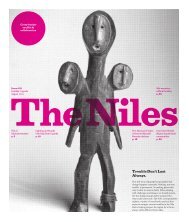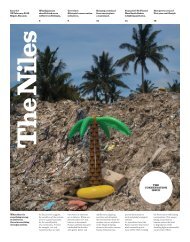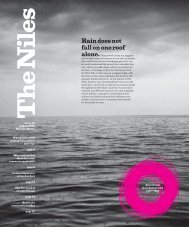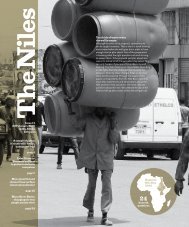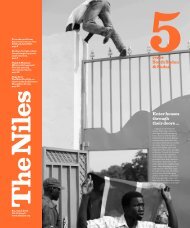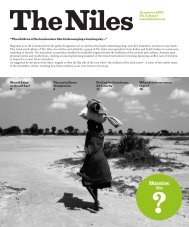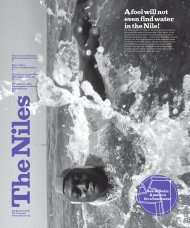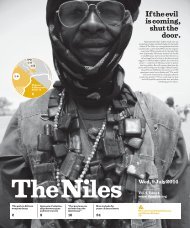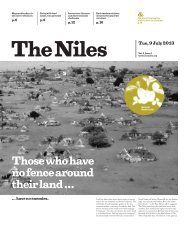A boat cannot go forward if each rows his own way
Be it to improve irrigation, manage floods and droughts or generate energy; dams have played a significant role in humanity’s progress. But the dam-building development model also has its flaws. The Niles journalists tackle the sensitive dam topic and self-aware that they all are in the same boat, they agree that it is time to start rowing the same way.
Be it to improve irrigation, manage floods and droughts or generate energy; dams have played a significant role in humanity’s progress. But the dam-building development model also has its flaws. The Niles journalists tackle the sensitive dam topic and self-aware that they all are in the same boat, they agree that it is time to start rowing the same way.
Create successful ePaper yourself
Turn your PDF publications into a flip-book with our unique Google optimized e-Paper software.
18 TN
“They
call
Atbara
Dam
Complex
‘The
White
Dam’.”
and they fled the area. It also impacted fruit trees, gardens and seasonal
farming, all that drowned, and it impacted people in many ways. Grazing
was also impacted as natural grazing lands were lost”.
“I don’t think that the government had followed the recommendations
of the studies done by Sogreah upon constructing the dam,” Suliman said.
“The former Minister of Health had stated that the bathrooms weren’t
fit as the pits were only 160 centimetres deep. But the Dams Implementation
Unit ignored that, leading to disastrous problems.
People usually dispose the waste from their bathrooms every three
months in the farms – they were told by local leaders that it helps
to fertilise the soil – and that led to even more contamination issues,”
Manahil Edris from The Supreme Council for Environment of el-Gadarif
State told The Niles.
“We formed a committee to address those issues and filed a complaint
to the Governor of el-Gadarif State about five years ago. That caused
a row and newspapers wrote about it, but shortly afterwards the National
Security stopped the process and told us not to pursue it any further.
Samia Mohamed, the General Secretary of the Council in el-Gadarif,
is determined to pursue the fight,” Edris added.
The resettlement
After the study and design phase in 2010, the Dam Implementation
Unit started to resettle people living close to the dam site. They had
Sogreah’s Preliminary Resettlement Action Plan from 2009, which
recommended that, as far as possible, World Bank policies must be
followed regarding involuntary resettlement, indigenous people and
cultural property.
These policies cover issues like eligibility for benefits and planning
instruments for involuntary resettlement.
The Preliminary Resettlement Action Plan acknowledges the dam’s
multiple impacts on the area, for example, loss of residential land, village
areas, buildings, socio-economic infrastructure, services (health units,
schools, markets), not to mention the loss of both agricultural and
non-agricultural income.
Besides, the building site and camps also affect the area, for example
through increased traffic, social disruption, loss to agricultural production
as farmers and their families are moved, loss in fish production, changes
to public transportation.
“Efforts have been made at this stage of the Preliminary Resettlement
Action Plan to minimise the displacement of villages and population,
to resettle in the vicinity of the present villages and to minimise also land
acquisition needed in actual rain-fed agricultural land, giving priority
to village reinstallation in not affected karab land or shrub savannah
in the neighbourhood of the rain-fed agricultural lands of the villages,”
the study states.
A member of the former administration of the Dam Implementation
Unit was asked for comment and detail on the relocation process and
compensation but declined to comment.
The dam also covered several historical sites that would be saved,
according to an arrangement between the Dam Implementation Unit
and the National Museum of Sudan from 2013.
The White Dam
Well-established houses,
infrastructure and basic
services fall behind what
was promised in towns
created for people who had
to make way for the Upper
Atbara Dam Complex.
Photos: The Niles / Elzahraa
Jadallah
“They call Atbara Dam Complex ‘The White Dam’ as it witnessed
no conflicts or protests from the locals upon construction, unlike other
dams in the country,” Abdulrahman Awadelsied, a resident of a town
of resettled people, told The Niles.
Some 13 new towns were created; eight complexes within el-Gadarif
State and three in Kassala. When the officials came, locals welcomed
the overall benefits of the dam. The population had been settled in the
area for hundreds of years and had houses, farms, livestock and services.
Awadelsied, like many citizens, has complaints about the
TN15_20210310.indd 18 2021/03/10 18:29




